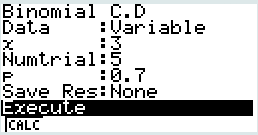Loi binomiale cumulée
Soit \(X \hookrightarrow \mathcal B(5 ;0,7)\). Utiliser la calculatrice pour calculer \(\mathbb P(X\leqslant 3)\).
On utilise la fonction "binomiale cumulée". la syntaxe est identique à la fonction "binomiale simple".
Méthode : Sur TI
La fonction s'appelle binomcf( et se trouve dans le menu \(\fbox{2nd}~\fbox{DISTR}~ ~A :binomcdf(\)
\(\mathbb P(X\leqslant 3)\approx 0,47\)

Méthode : Sur Casio

La fonction s'appelle Bcd et se trouve dans le menu \(\fbox{MENU}~ STAT 2\) puis \(\fbox{F5}~ DIST~ ~ \fbox{F5} ~ BINM~ ~ \fbox{F1}~Bcd\)
On complète les zones de saisie en indiquant Data : Variable
On obtient le résultat sur l'écran ci-contre :

Complément :
Pour calculer \(\mathbb P(3\leqslant X\leqslant 4)\) on peut calculer \(\mathbb P(X\leqslant 4) - \mathbb P(X\leqslant 2)\).
En effet l'événement \((X=3)\) doit être compris dans le calcul. Il ne faut donc pas le retrancher.

Ici on voit que :
\(\mathbb P(3\leqslant X\leqslant 4)\approx 0,67\)